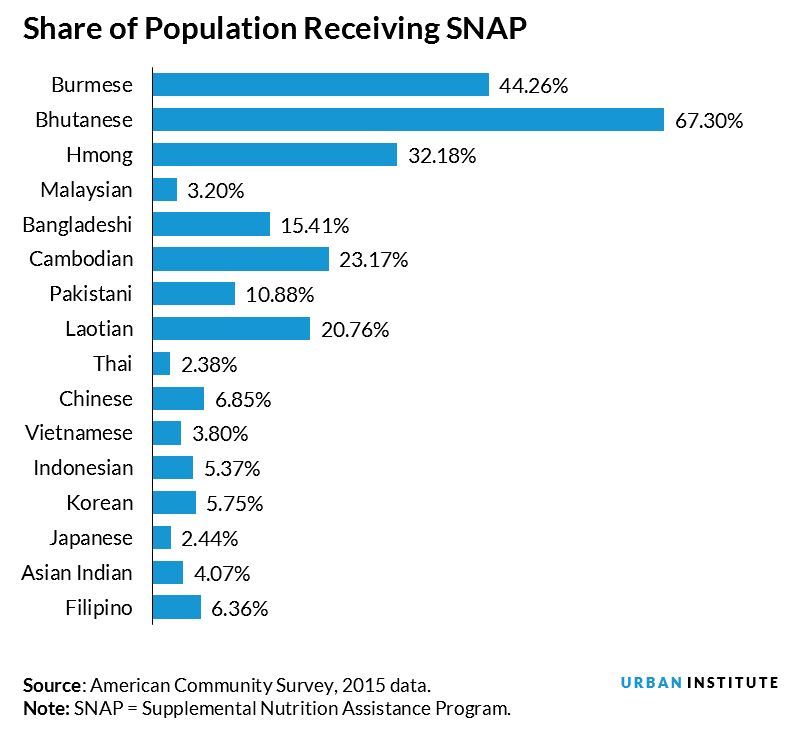
Photo by Ballyscanlon/Getty Images.
The conversation around Asian American representation in the US frequently focuses on their underrepresentation in management positions, public office, and the media. But Asian American groups are often missing from data as well, specifically data on poverty and access to social services.
Although the Asian American, Native Hawaiian, and Pacific Islander (AANHPI) population is smaller than other racial groups (6.2 percent of the US population), undersampling or not including it in research obscures the needs of those living in poverty and perpetuates the stereotype that few Asian Americans live in poverty or need social services.
Researchers fear that hard-to-count populations like AANHPIs might be undercounted in the 2020 Census and in administrative data. Representation in data is important for improving equity in access to social services and ensuring social service programs reach populations in need.
Not all Asian Americans are wealthy, and social services aren’t reaching those in need
Despite assumptions that all Asian Americans are high earners, 12.3 percent of Asian Americans live below the federal poverty level, ranging from 6.8 percent of Filipino Americans to 39.4 percent of Burmese Americans, according to the American Community Survey (ACS). Almost 20 percent of Native Hawaiians and Pacific Islanders live in poverty.
The large wealth gap between Asian American groups shows how the Asian American umbrella includes ethnic groups who vary substantially in economic status, tenure in America, and education levels. Those differences are even more significant when evaluating access to services for communities that need them.
In 2014, Asian Americans represented 17.9 percent of people living in poverty in New York City and had the highest poverty rate of any racial or ethnic group at 29 percent, according to NYC Opportunity tabulations provided to Urban Institute researchers. But Asian American community organizations received only 1.4 percent of the total value of the city’s social service contracts and 1.5 percent of total contract dollars from the Department of Social Services.
A lack of funding for Asian community organizations leads to Asian New Yorkers receiving insufficient and limited direct support to meet their social service needs. Limited funding and support can stem from various factors, including insufficient program outreach, given the stereotype that Asian Americans do not need public assistance programs, a lack of culturally appropriate services, and language barriers.
How SNAP assistance varies among Asian American ethnic groups
The Supplemental Nutrition Assistance Program (SNAP) has a substantial antipoverty effect and reduces food insecurity. In 2015, SNAP removed 8.4 million people from poverty, reducing the poverty rate from 15.4 percent to 12.8 percent when calculated using the supplemental poverty measure.
In 2015, 2.6 percent of SNAP recipients were categorized as Asian American even though 4.5 percent of people in poverty in the US are Asian American.
Among Asian Americans, ethnic groups vary widely in their access to SNAP and other public assistance programs. Tabulations from the ACS show that in 2015, while some ethnic groups received SNAP at rates as high as 67 percent (Bhutanese), others were severely underrepresented in the SNAP population.
Although Malaysian Americans had a poverty rate of 25.1 percent, only 3.2 percent of Malaysians received SNAP. Only 2.4 percent of Thai Americans received SNAP while their poverty rate was 16.7 percent, and 3.8 percent of Vietnamese Americans received SNAP while the community’s poverty rate was 15.3 percent. In comparison, 15.5 percent of the US population was in poverty and 13.7 percent received SNAP.

But SNAP is substantially underreported in the ACS results cited above. Families might not report receiving SNAP assistance because of perceived stigma, because they forgot to report benefits received earlier in the year, or because they might be unaware of the benefits other household members received.
There might be differences in underreporting of SNAP among different Asian ethnic groups that are not represented in the data. Without accurate sampling and data collection, we cannot understand which Asian groups face barriers to accessing SNAP benefits and how much.
Why we need targeted outreach to ensure Asian Americans are fairly represented in data
Because the Asian American population is small compared with other racial groups, it is often undersampled and homogenized in research.
The Pew Research Center has documented the difficulties of surveying the Asian American population. In small-sample studies, there is a high margin of error when sampling Asian Americans given their small population and wide diversity. Even in large surveys, limited English proficiency and high linguistic and ethnic diversity make it difficult to have a representative sample of Asian Americans.
Given the difficulty of surveying Asian Americans and their wide economic diversity, Asian Americans are often excluded from conversations about poverty and social services. Without targeted outreach and efforts to accurately sample the entire Asian American population, the needs of Asian Americans, Native Hawaiians, and Pacific Islanders living in poverty might be overlooked when evaluating access to social services.
Let’s build a future where everyone, everywhere has the opportunity and power to thrive
Urban is more determined than ever to partner with changemakers to unlock opportunities that give people across the country a fair shot at reaching their fullest potential. Invest in Urban to power this type of work.